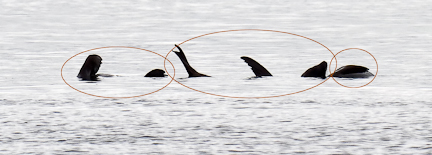Feb/07/11 09:29 PM
Seal Sitters received calls late this morning from concerned citizens regarding a marine mammal “entangled” approximately 100 yards offshore at Lincoln Park. Our responder followed up on the report, but as she suspected, it was three California sea lions snoozing in the water. Often sea lions sleep in small or large groups - a behavior called
rafting - with only a flipper or tail visible to help them regulate their body temperature. Periodically, a nose will pop out of the water briefly for a breath and then disappear. It is an unnerving sight to those who are not familiar with the behavior.
Tags: rafting behavior, sailing sea lion, thermoregulation, California sea lion
Feb/21/10 07:55 PM
A California sea lion created concern among Lincoln Park beach walkers today. The sea lion was regulating his body temperature (“thermoregulation”) by floating and raising his flippers out of the water, a behavior called “sailing.” This is often mistaken for injury or illness and even sometimes reported to authorities as an injured orca or other whale. The sight was particularly disturbing to onlookers following the recent shootings of sea lions in our area. When a number of sea lions group together and exhibit this behavior, sometimes sleeping with their noses just above water, it is termed “rafting”. In the winter of 2007, an estimated 200 sea lions “rafted” off Jack Block Park, flooding the NOAA Stranding Hotline with calls reporting an “orca pod” in Elliott Bay.
So, what exactly is thermoregulation? Sea lions and other pinnipeds have a system of veins and arteries that transfer heat to the rest of their bodies and organs. By extending their flippers out of the water, the blood in that less insulated part of the body absorbs heat from the sun or warmer air, and circulates it through the body to their internal organs. Conversely, on a hot day, you may see a sea lion with flippers to the wind, cooling the blood which then circulates and reduces body temperature.
Read more about sea lions on our website.
Tags: thermoregulation, sailing sea lion, rafting behavior









